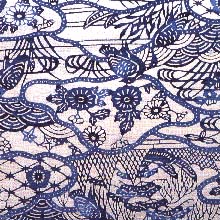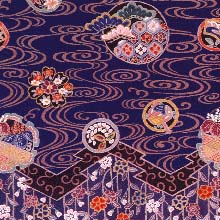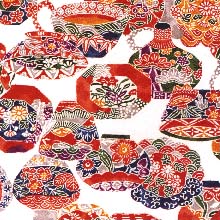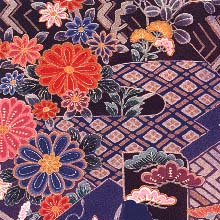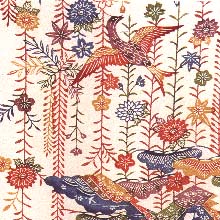Dye (p. 145 )
1. Produed in Naha City, Tamagusukumura, Tomigusukumura Shimajirigun, Okinawa Prefecture.
2. Characteristics: A dyeing process producing the designs of birds, or moon with brilliant colors peculiar to a tropical atmosphere. "Bin(vermilion) gate" is a design dyed with some shades of indigo. In addition, there are paper pattern dyeing and cylinder dyeing("Tsutsugaki Zome").
3. Uses: Clothes for women, "Haori"(half coat), sashes, "Noren"(shop curtains), wall hangings, table cloths, wrapping cloths, pouches, etc.
4. History: The origin is not clear but is presumed to be in the 15th century. The dyeing is presumably influenced by "urashi gata," a stencil dyeing transmitted from China, and by the dyeing techniques and designs in mainland Japan. As "Bingata" was used for garments for the ruling class in the Ryukyu Dynasty and also used as a trade item, the Bingata technique has been maintained until today by 3 families. In the days of the Ryukyu Dynasty, the color of cloth of the background and the designs were different and based on status. The aristocrats used the "Bingata" of silk crepe or figured satin("Rinzu") with picturesque and multi-colored large designs on a white background or light yellowish color. The common people used cotton cloth with simpler designs dyed in 5 colors or 2(indigo and black) colors. "Bingata" was imported to mainland Japan during1688-1704, and was loved very much. The production decreased drastically after the Ryukyu Dynasty was abolished in 1879 and totally abolished in WWII, revived after WWII.
Dyeing Method
The plant dyes used are "Ryukyu Ai(indigo)," "Fukugi"(a high tree of Hypericum erectum family), "Suo"(Caesalpinia sappan) and "Yamamomo"(Myrica rubra), and as pigment, "Shoenji"(cochneal), "Shu"(cinnabar), "Sekio"(orpiment), "Sumi"(Indian ink) and "Gofun"(aleurone). For the purpose of fixing the color to the cloth, "Gojiru" liquid obtained from ground soy beans, is used with pigment and alum with plant dyes. Plant dyes are painted over the pigment.
Kinds of techniques
1. "Shiruji(white background) gata" Only the designs are dyed with resistant being applied on the background, leaving it white.
2. "Sumiji(dyed background) gata" Both designs and background are dyed at the same time. The resistant applied on the part of the designs which should be white.
3. "Keshi gata" This is a step to follow "Shiruji gata" (1), in which designs are dyed. The background is dyed after the resistant is applied on the designs.
4. "Uburu(shading) gata" A technique to give designs to already dyed background with techniques (1) and (2).
5. "Dan Zome Ji gata" The color of the dyed background is largely divided into 2 parts by a horizontal line.
6. "Shinobu gata" After the dyeing is finished, it is followed by gradation and hand-dyeing.
7 "Tetsuke Bingata" After washing in water, the white parts are colored.
Kinds of "E gata"
1. "Shiroji E gata": Designs are all in one tone of indigo on white background.
2. "Asaji Hanatori": Designs with different shades of indigo.
3. "Kurohana(black flower) dashi": White designs on indigo background.
4. "Shirohana(white flower) dashi": White designs on indigo background.
5. "E Uburu": Double dyeing in indigo with techniques (1) and (2).
6. "Sumiji E gata":Gradation is given to designs with Indian ink.
7. "Bin Iri E gata": Such colors as red, yellow or blue, are added to the indigo part.
